#president warfield
Explore tagged Tumblr posts
Text
Soldados británicos evacuando judíos del barco Éxodo en el puerto de Haifa, 18 de julio de 1947

El 11 de julio de 1947, el barco Presidente Warfield partió de Francia hacia la Tierra de Israel con 4.500 pasajeros, en su mayoría sobrevivientes del Holocausto. Rebautizado como Éxodo 1947, fue atacado el 17 de julio por destructores británicos en aguas internacionales y remolcado a Haifa el 18 de julio. Debido a esto, el gobierno británico ordenó deportar a los pasajeros. Se embarcaron en tres barcos británicos: Empire Rival, Runnymede Park, y Ocean Vigour. Francia no permitió el desembarco, y los pasajeros fueron mantenidos a bordo durante más de tres semanas antes de ser enviados a Alemania. Allí, fueron desembarcados por la fuerza en Hamburgo y llevados a campos de personas desplazadas. El trato inhumano hacia los pasajeros del Éxodo 1947 causó indignación a nivel internacional.

On July 11, 1947, the ship President Warfield set sail from France to the Land of Israel with 4,500 passengers, most of them Holocaust survivors. Renamed as Exodus 1947, it was attacked on July 17 by British destroyers in international waters and towed to Haifa on July 18. As a result, the British government ordered the deportation of the passengers. They were transferred to three British ships: Empire Rival, Runnymede Park, and Ocean Vigour. France did not allow disembarkation, and the passengers were kept aboard for over three weeks before being sent to Germany. There, they were forcibly disembarked in Hamburg and taken to displaced persons camps. The inhumane treatment of the passengers of Exodus 1947 caused international outrage.
#11 de julio de 1947#1947#julio 1947#presidente warfield#warfield#francia#britain#british mandate#palestina#israel#eretz israel#france#ocean vigour#runnymede park#empire rival#éxodo 1947#judaísmo#jews#judaism#president warfield#land of israel#british#germany#hamburg#jewish#judío#historia judía
1 note
·
View note
Text

On July 11, 1947, the Exodus (formerly the packet steamer SS President Warfield) was intercepted by the British Navy off the coast of Haifa. The ship was carrying 4,500 Jewish men, women and children, virtually all of them Holocaust survivors. The ship was escorted into port, where the exhausted bedraggled passengers were transferred to three other ships, Ocean Vigour, Empire Rival and Runnymede Park and, quite incredibly, returned to Germany (after first docking in France where, on the advice of the Haganah, the passengers refused to disembark). They were then placed in DP (displaced persons) camps. Try to imagine the sheer horror of being returned to Germany after surviving the Holocaust. By the time Israel declared independence, most (by various means) were able to complete the journey they had begun in hope the previous year. The second vessel is one of four new state-of-the-art Sa'ar 6 warships that will patrol Israel's coastline and protect its people for many years to come.
Likud Herut UK
19 notes
·
View notes
Text
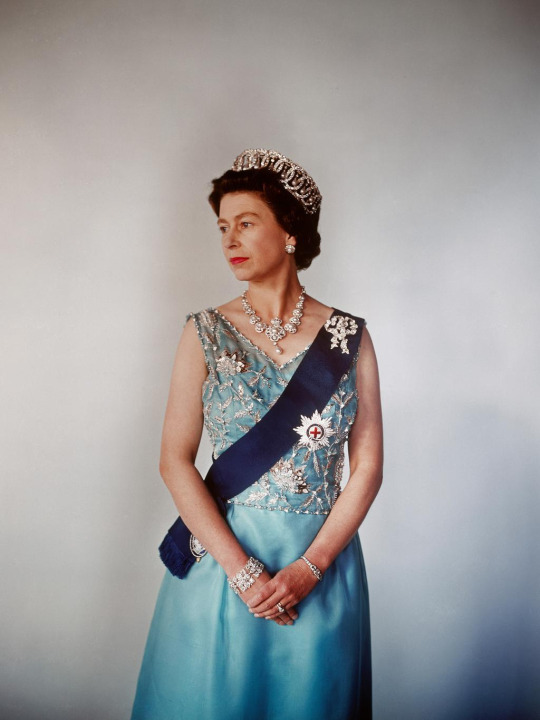
QUEEN ELIZABETH II
By Steve Dougherty and Larry Sutton | Published 17 September 2022
Time Magazine International Edition
QUEEN ELIZABETH II WAS THE WORLD’S LONGEST-serving head of state when she died at 96 on Sept. 8. She had led her subjects for more than seven decades—an extraordinary reign that began in 1952, and spanned 15 British Prime Ministers and 14 U.S. Presidents. She inherited the throne of a country almost broken by the legacy of war, and remained upon it through a time of epochal change for both the U.K. and the world.
When Elizabeth took the throne, the U.K. was the seat of an empire that straddled the globe. Today, Britain is a smaller player on the world’s stage, but she remained the sovereign leader of 15 nations—including Australia, Canada, and New Zealand—and head of a Commonwealth of more than 50 nations. She traveled the globe as an ambassador for British achievements, acts of charity, and values. She was also devoted to upholding the “special relationship” between the U.K. and the U.S., engaging with every President from Harry Truman to Joe Biden over a period of more than 70 years. And even as the world changed in profound ways, many saw her as a steadfast rock of patriotic duty. As her grandson Prince William wrote in the preface to a 2015 biography, “I think I speak for my generation when I say that the example and continuity provided by the Queen is not only very rare among leaders but a great source of pride and reassurance … I am privileged to have the Queen as a model for a life of service to the public.”
ELIZABETH ALEXANDRA MARY WINDSOR was born by cesarean section at 2:40 a.m. on April 21, 1926. She was an heir to the throne, but third in the line of succession. Her father Prince Albert—Bertie to friends and family—was the second son of the reigning monarch, King George V. His older brother David, known by his royal appellation Edward of Wales, was first in line to the throne—but also single, childless, and already rumored to have little interest in inheriting his father’s crown.
The early life of Princess Elizabeth was chronicled with zeal both by the British press and in the former colonies. “The water was from the River Jordan,” TIME reported of the elaborate christening pageantry staged in the private chapel at Buckingham Palace. Sir Winston Churchill first met Elizabeth at Balmoral Castle in 1928, when she was 2, and proclaimed that he saw in her “an air of authority and reflectiveness astonishing in an infant.”
No one in the realm was more enamored with the young Elizabeth than its monarch, who gave her the place of honor on his lap when they rode through the streets of London in his royal stretch Daimler. “No one else except the Queen rides out so often with the King,” TIME reported. Left out of the spotlight, not ungladly, was Lilibet’s father—the self-deprecating Bertie, who once told reporters, “My chief claim to fame seems to be that I am the father of Princess Elizabeth.”
Her reign as only child ended at age 4, in 1930, with the birth of her sister, Margaret Rose, at Glamis Castle in Scotland, their mother’s ancestral home. The girls romped together on the palace grounds and royal country estates, played with their terrier puppies and corgis—Elizabeth’s lifelong favorite. They also stabled, cared for, and learned to train a royal succession of pet ponies, and shared the same nannies and governesses.
In January 1936, upon the death of Lilibet’s grandfather George V, her uncle David became King Edward VIII. Almost immediately, his eldest niece and all the royal family became prime players in a 20th century succession drama. Edward’s tumultuous 10-month reign as King ended on Dec. 10, 1936, when he scandalized the world by abdicating the throne to marry the twice-divorced American socialite Wallis Warfield Simpson. “I always told those idiots not to put me in a golden frame,” he said. Young Lilibet was only 10 when she learned she would become Queen after her father’s death.

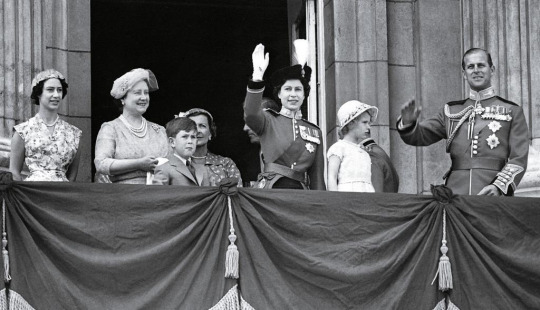
ELIZABETH WAS BARELY A TEENAGER when, on Sept. 3, 1939, Britain declared war on Nazi Germany. The war’s threat had already thundered throughout Europe, and soon the kingdom Elizabeth would one day rule, along with much of the rest of the world, was engulfed in war. Less than a year later, Hitler entered Paris and promised to make Britain his next conquest. Soon the Blitz—day and night Luftwaffe bombing raids that rained fire and terror over cities throughout England—was at full roar.
And so the Princess spent her teens knitting socks for British soldiers, collecting tinfoil, and rolling bandages for the war effort. She would send portions of her 5-shilling weekly allowance to emergency child-welfare funds, wear secondhand clothes, adhere to the war-rations diet dictated for all Britons, and live frugally despite being a teenage Princess and heir to the British throne.
Even as bombs fell on Buckingham Palace, the royal couple refused entreaties to abandon London and evacuate Princess Elizabeth and Princess Margaret to Canada. “The children won’t go without me,” said the Queen. “I won’t leave without the King. And the King will never leave.”
The King’s decision to remain in England for the duration of the war, enduring its deprivations along with his subjects, endeared him to the beleaguered nation. But it also made the likelihood that Elizabeth might suddenly be called to the throne in the event of her father’s death seem palpable.

The future monarch began her public life with her first live BBC radio broadcast in October 1940. Displaying poise and pluck, she addressed the tens of thousands of children who were evacuated from their homes and separated from their families at the height of the Blitz. “My sister, Margaret Rose, and I feel so much for you as we know from experience what it means to be away from those we love most of all,” she said in a clear voice that offered a hint of the calm and compassion that many would come to admire.
When in 1944 she reached military age at 18, Elizabeth joined the Auxiliary Territorial Service, one of the wartime women’s units. She spent three weeks at the Mechanical Transport Training Center, where she trained as a mechanic and truck driver. The labor left her covered in grease and grime and not a little well-earned pride.
And she never partied so hard as she did a fortnight after her 19th birthday when, on May 8, 1945—Victory in Europe Day—she joined the ecstatic and rowdy street celebrations that swept London following Germany’s surrender. After standing in uniform on the balcony at Buckingham Palace to greet cheering crowds alongside the King, Queen, and Prime Minister Winston Churchill, she, her sister, a group of friends, and a few guardians linked arms and ran among the crowds that surged through the city. For two nights in a row she “walked simply miles,” she wrote in her journal, “ate, partied, bed 3 a.m.!” These were, she would say 40 years later, among “the most memorable nights of my life.”
YEARS BEFORE, ELIZABETH had visited a naval college at Dartmouth where she had been greeted by a towering 18-year-old cadet.
Prince Philip of Greece and Denmark was born on the Greek island of Corfu on June 10, 1921, nephew of King Constantine of Greece and distant relation to Britain’s Queen Victoria. As his family drifted apart he was sent, at the age of 9, to England to live with his grandmother, the widow of the great British naval commander and German Prince Louis Alexander Mountbatten. He was schooled in England, Germany, and Scotland, and became a fine young athlete—as Elizabeth would note to her governess, Crawfie, on that trip to Dartmouth: “How good he is, Crawfie. How high can he jump!”
Elizabeth corresponded with Philip throughout the war, and after its end the Prince was placed on shore duty at a naval base on England’s south coast. He often made the 100-mile trek to London in his small black MG, frequently stopping at Buckingham Palace. As the friendship grew into a romance, Elizabeth was delighted. Her father George? Not so much—at first. “His loud, boisterous laugh and his blunt, seagoing manners … irritated the gentle King,” TIME reported in 1957. Despite that chill, Elizabeth and Philip decided to marry after a short stay with her family at Balmoral Castle in the summer of 1946. The King’s lack of enthusiasm for Elizabeth’s beau—an attitude sparked, in part, by his concern over how the people of Britain would take to a foreign-born prince marrying the heiress to the throne—frustrated the Princess. “There was many a tense moment for George as Elizabeth moped about in tearful martyrdom while her mother and grandmother, the doughty old Queen Mary, fought her battle for her. At last, George decided that the young couple (she was 20, he 25) should wait six months to make sure of each other,” noted TIME.
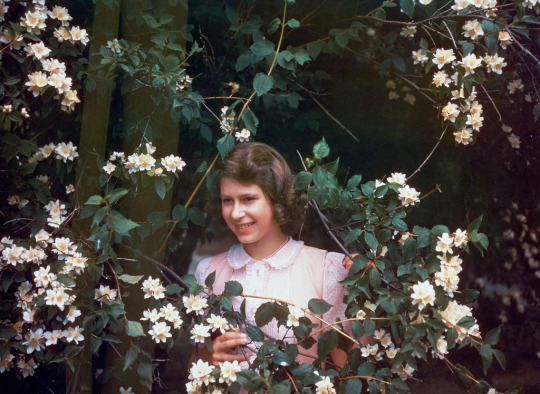
There were obstacles to overcome, but none insurmountable. Philip became a British citizen, and public-opinion polls showed that a majority of the nation’s populace favored his marrying the Princess. The official announcement did not come until July 9, 1947, followed by the couple’s introduction at a Buckingham Palace garden party. The wedding took place that November, on the 20th. Philip had converted from Greek Orthodoxy to Anglicanism, and Elizabeth’s father made the former member of the Greek and Danish royal families a British royal duke, the Duke of Edinburgh, to be called His Royal Highness, or simply Prince Philip.
As Elizabeth made her way to Westminster Abbey in the royal coach on her wedding day, thousands cheered from the neighboring sidewalks of London. Celebrations erupted throughout the globe, from Paris to Panama, from Shanghai to Manhattan—where thousands got out of bed at 6 a.m. to listen to the ceremony broadcast on the radio. Dignitaries—five Kings, six Queens, Prime Minister Clement Attlee, Winston Churchill—were in attendance. All of Britain celebrated, many seeing the wedding as a beacon of hope in the post–World War II recovery period.
ON FEB. 5, 1952, Princess Elizabeth went to bed in a tree hut nestled in Kenya’s Aberdare National Park and awoke the next day as the Queen of England. She was unaware of her new position, for news of the death of her father King George VI had not yet reached that outpost of the British Empire. That afternoon, at a lodge, Philip received a phone call informing him of George’s death. The Prince took his bride down to a nearby river’s edge and relayed the news. Shaken, but in full command of herself, Elizabeth returned to the lodge and began making arrangements for the long trip home.
Elizabeth arrived at London’s airport the following morning. Churchill was there to greet her, along with a small group of privy councilors—advisers to the monarchy. That night she rested; the next day she signed the oath of accession before the Privy Council, and an hour later her accession was formally proclaimed. In the months that followed, there was no hurry to arrange her formal coronation—she was already, technically, the Queen. So Elizabeth and the Palace allowed the focus to stay on King George and his 16 enormously popular years on the throne, and let the nation’s sadness ebb.
The ceremony finally took place on June 2, 1953, a day chosen in hopes of sunny spring weather. This being London, however, the nation settled for a traditional gray morning. At 11 a.m., a joyous fanfare of trumpets announced the arrival of Her Majesty. “Vivat Regina Elizabetha! Vivat! Vivat! Vivat!” shouted the Queen’s Westminster Scholars as she walked up the aisle, her long crimson train borne by six maids of honor. The Archbishop of Canterbury proceeded to ask Elizabeth if she would govern her people according to their laws and customs, execute law and justice in mercy, and maintain the laws of God. She knelt, kissed the Holy Bible before her, and swore to do so, “so help me God.” Finally, he held aloft the Imperial State Crown for all to see, then placed it on Elizabeth’s head. Cheers of “God Save the Queen” filled the abbey as trumpets blared; outside, and across the British Empire, bells pealed and cannons roared.
AS WELL AS the constitutional duties Elizabeth fulfilled as Britain’s head of state and the head of the Church of England, she spent long sections of the following decades traveling the world as her nation’s goodwill ambassador. The November after her coronation she embarked on a 45,000-mile tour of the British Commonwealth, presiding over state balls, garden parties, luncheons, banquets, and other occasions. Among her stops: Libya, Australia, Fiji, New Zealand, Jamaica, Uganda, and the Pacific island of Tonga. She did not return to London until May 15, 1954, almost six months after she departed.
In the fall of 1957, Elizabeth and Philip spent six days in New York City; Washington, D.C.; and parts of Virginia, where they celebrated the 350th anniversary of the founding of the first British colony in America. In Washington, they were guests of President Dwight D. Eisenhower—a friend since his days in London during World War II—for four nights at the White House. At the state dinner, Elizabeth praised Washington as “so often a focus for the aspirations of the free world.” Later, Vice President Richard Nixon hosted a luncheon at the Capitol, and Elizabeth sought to see how the average American enjoyed life, attending a college football game and stopping in a Giant supermarket.
Clearly, the travel bug had bitten. In 1961, Elizabeth visited India, and at the Ramlila Grounds near Old Delhi, a quarter of a million people came to see her speak. In the city of Jaipur, the Maharaja offered her a ride on a ceremonial elephant. Though the trip was a success for Elizabeth, it also put the Indian government on edge—it viewed such a display of colonial pageantry as undermining the country’s fledgling independence. Philip also drew negative publicity when official photos emerged of a tiger he’d killed on a hunt with the Maharaja.
In Ghana that same year, Prime Minister Kwame Nkrumah told the Queen, “The wind of change blowing through Africa has become a hurricane.” (Ghana had declared independence from the British Empire in 1957, though the legacy of colonialism still hung over the country.) Tanzania would declare independence later that year, joined by Kenya in 1962 and a series of other African nations throughout the 1960s.
In 1965, Elizabeth embarked on an 11-day tour of West Germany, the first state visit by a reigning British monarch since Edward VII had paid his last call on Kaiser Wilhelm II in 1909. The trip came a full two decades after the end of World War II, amid fears of lingering resentment between the U.K. and Germany. But those fears were misplaced. The Queen and German Chancellor Ludwig Erhard said all hostility between their countries had been healed in the 20 years since the war. It ended in triumph, with crowds cheering and chanting “Elizabet, Eliz-a-bet!” as she placed a wreath on a Beethoven monument near the Bonn city hall.
BUT ALL THAT TRAVELING would put a strain on her family. That world tour following her coronation took place when Charles was 5 and Anne only 3—and the children were left behind. They did chat with their traveling mother by radiotelephone. But this would go on to be characteristic of Elizabeth, who always tended to make work her priority.

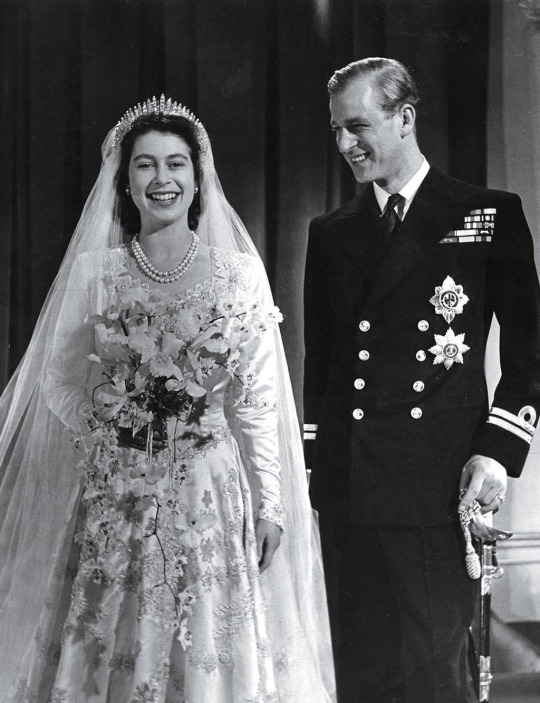
Years later, in 1994, Prince Charles would allow his authorized biographer to disclose that the prince felt “emotionally estranged” from his parents. Close friends found the Duke’s behavior “inexplicably harsh” and called his manner toward Charles “very bullying.” His mother, the Queen, seemed “detached.” Elizabeth and Philip were reported to be hurt by this disclosure. Publicly, only Philip would comment: “We did our best.” Princess Anne exercised less restraint, defending Elizabeth from rumors that she was remote. “I simply don’t believe that there is any evidence whatsoever to suggest that she wasn’t caring,” she said in 2002. Yet even Anne might have acknowledged a warmth that was sometimes wanting on her part later in life—when a little more compassion, a little more kindness, might have been called for.
The early 1990s would bring all kinds of personal problems to the fore—most notably in 1992, which the Queen famously described in a speech as an “annus horribilis” (horrible year). This was the year when her second son, Andrew, separated from his wife Sarah; when daughter Anne divorced her husband Mark Phillips; when her son Charles and his wife Diana increasingly became a tabloid issue; and when public concern grew about the cost of the monarchy and who would pay to repair Windsor Castle, which caught fire that year.
The damage was significant. The Nov. 20 fire—on the Queen’s 45th wedding anniversary—gutted the northeast corner of the castle, parts of which were more than 900 years old. It took 250 firefighters 15 hours to bring it under control. In the end more than 100 rooms, covering an area of 1.7 acres, were damaged. When British citizens learned that they were about to foot the bill for repairs to Windsor Castle—to the tune of up to $78 million—they grumbled. Elizabeth rectified the issue by volunteering to pay income and capital gains tax from her private investments. It hurt, but not too much: Her net worth remained at about $500 million.
But these were simply matters of state. Matters of the heart caused greater grief for Elizabeth—particularly the travails of Charles and Di. Their courtship and 1981 marriage captivated the nation, if not the world. No less an authority than the Archbishop of Canterbury proclaimed, “Here is the stuff of which fairy tales are made: the Prince and Princess on their wedding day.” But infidelity would intrude on both sides, and the ability to maintain the pretense of marriage for the sake of appearances became impossible. On Aug. 24, 1992, the transcript of a phone conversation between Diana and a close friend was published in the Sun, with Diana describing life with Charles as “real torture,” and saying she had caught the Queen Mother watching her “with a strange look in her eyes.” Diana and her young sons, William and Harry, continued to reside at Kensington Palace, while Charles’ relationship with Camilla Parker Bowles was parsed by the tabloid press. The Prince and Princess of Wales officially separated on Dec. 9.
Diana’s decision to grant an interview to the BBC on Nov. 20, 1995, in which she confessed that she had been unfaithful to Charles, had upset the royal family, and Queen Elizabeth in particular. (Of course, Charles had admitted his own infidelity on a TV documentary the previous year, as Diana noted in the interview.) Within a month, the Queen wrote to both Charles and Diana, urging them to agree to an early divorce. Buckingham Palace released a statement saying Charles favored the divorce, but there was no official word from Diana. In February 1996—more than a year before Diana, her romantic partner Dodi Fayed, and driver Henri Paul died in a car crash while being pursued by the paparazzi—she finally released her own statement saying she was ready to divorce too.
It took time for Elizabeth—a woman married seven decades to the same man—to adjust to modern mores. A longtime sticking point was Charles’ future bride Camilla; the press noted that Elizabeth was not enamored of her son’s consort. A shift occurred in 2002, when, by bringing Camilla to events celebrating Elizabeth’s 50 years on the throne, Charles provided strong evidence that he was gaining ground in his campaign to officially bring Camilla into the family fold.

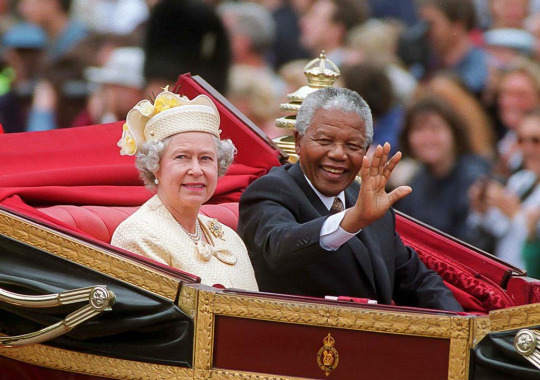
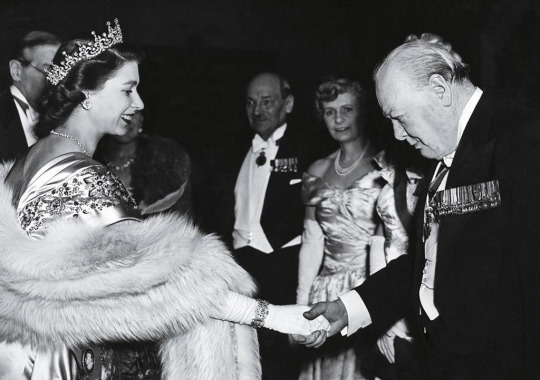
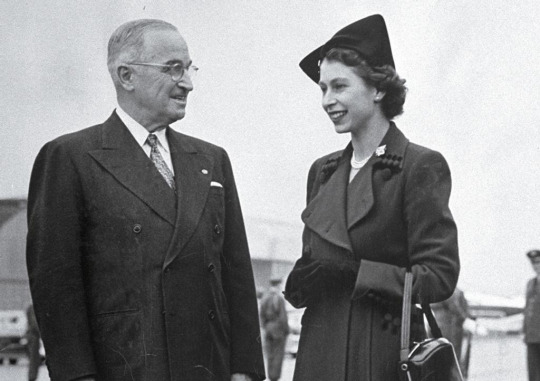

Charles and Camilla got engaged around Christmas 2004, and before long the Queen issued a statement saying, “The Duke of Edinburgh and I are very happy that the Prince of Wales and Mrs. Parker Bowles are to marry.” She and Prince Philip did not attend their wedding at Windsor Guildhall on April 9, 2005, but they did attend a blessing of the couple at St. George’s Chapel in Windsor Castle and held a reception for them at the castle.
A more festive wedding—and one more in keeping with Elizabeth’s sense of tradition—took place on April 29, 2011, when Elizabeth’s grandson William married Kate Middleton in a lavish ceremony at Westminster Abbey. And she remained her regal self at Prince Harry and Meghan Markle’s more modern wedding at Windsor Castle in 2018, which included a fiery sermon delivered by Bishop Michael Curry of Chicago, the first African American head of the Episcopal Church in the U.S.
But in a televised interview with Oprah Winfrey in March 2021, Harry and Meghan alleged that racism had tarnished their relationship with the Windsors. While the press hounded Meghan as they did Harry’s late mother, “no one from my family ever said anything,” Harry said.
The family was once again thrust into the spotlight when allegations surfaced about Andrew’s relationship with the late sex offender Jeffrey Epstein. Andrew stepped back from royal duties in late 2019, and in 2021 was served with a lawsuit by Virginia Giuffre, one of Epstein’s victims, who accused Andrew of sexually abusing her when she was 17. According to the Daily Telegraph, the Queen contributed millions to her son’s legal defense, and agreed to contribute £2 million ($2.7 million) to a survivor-support charity as part of a settlement.
But family was also a source of comfort. As the Queen neared the end of her life, she doted on her grandchildren and great-grandchildren. “In a small room with close members of the family, then she is just a normal grandmother. Very relaxed,” Harry said before he and Meghan stepped back as working royals in early 2020. “She obviously takes a huge interest in what we all do.”
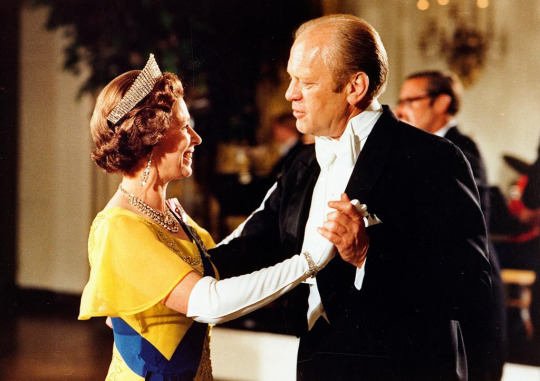



EVEN AFTER SHE ENTERED her ninth decade, Elizabeth continued with her royal duties, despite her age and a rapidly changing world.
For nearly all her reign, the Queen would read a selection of the 200 to 300 letters that she received daily, as well as review official papers and documents sent her way from government ministers and her representatives in foreign countries. Until she was forced to slow down by mobility issues and bouts of ill health, she would have 10- to 20-minute audiences with ambassadors, commissioners, and other officials, and there would be her weekly visit from the British Prime Minister.
Despite growing republican movements within the Commonwealth realms, the Queen herself remained a hugely popular figure in both the U.K. and beyond. And she remained a force for good, offering messages of inspiration and optimism in even the most trying times. In one of her last annual Christmas Day messages, she urged her subjects in Britain and across the Commonwealth to draw inspiration from “ordinary people doing extraordinary things.”
To many, she embodied the steadfastness she urged in others. At Prince Philip’s funeral, held shortly after he died on April 9, 2021, after 73 years of marriage, the monarch solemnly sat alone in a pew at Windsor Castle because of coronavirus restrictions. The image became instantly iconic, and further burnished her legacy as a stoic leader through good times and bad.
The Queen has been a constant figure in most of the British public’s living memory. Difficulty moving prevented her from attending the majority of Buckingham Palace’s Platinum Jubilee celebrations, as the nation in June 2022 marked her 70th year on the throne—a first for a British monarch. But community celebrations were widespread across the U.K. Some 16,000 official street parties were organized, and almost 17 million people—about 1 in 4 Brits—took part in events.
The Queen did not lead an ordinary life, but she filled it with inspiring acts of duty both public and private—whether carrying out the requirements of the state from the trappings of the throne, or giving quiet words of encouragement to a well-wisher in a crowd. She “has been a rock of stability in an era in which our country has changed so much,” said Britain’s former Prime Minister David Cameron. “And we could not be more proud of her. She has served this country with unerring grace, dignity, and decency.” —With reporting by ELOISE BARRY, KATHY EHRICH DOWD, MADELINE ROACHE, and YASMEEN SERHAN
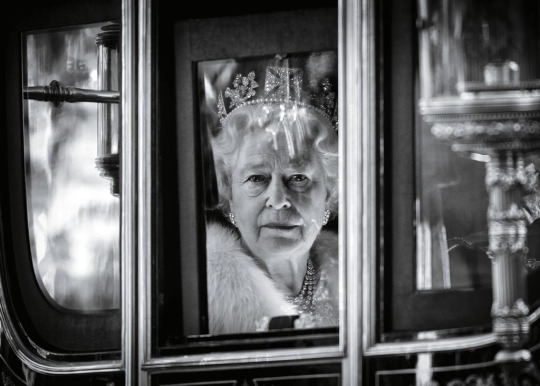
PHOTOGRAPH BY © CECIL BEATON—VICTORIA AND ALBERT MUSEUM, LONDON
TOPICAL PRESS AGENCY/GETTY IMAGES
1956: INTERCONTINENTALE—AFP/GETTY IMAGES; 2019: PA WIRE/AP; SUCCESSION: GETTY IMAGES (13)
1941: LISA SHERIDAN—STUDIO LISA/GETTY IMAGES; 1945: MIRRORPIX/GETTY IMAGES
1947: HISTORIA/SHUTTERSTOCK; 1961: FOX PHOTOS/GETTY IMAGES
LEFT TO RIGHT, FROM TOP LEFT: JULIAN PARKER—UK PRESS/GETTY IMAGES; GEORGE SKADDING—THE LIFE PICTURE COLLECTION/SHUTTERSTOCK; UNIVERSAL HISTORY ARCHIVE/GETTY IMAGES; TOM STODDART—GETTY IMAGES; GAMMA-KEYSTONE/GETTY IMAGES; TIM GRAHAM PHOTO LIBRARY/GETTY IMAGES; BETTMANN ARCHIVE/GETTY IMAGES; JANE BARLOW—POOL/AP
PHOTOGRAPH BY MAX MUMBY—INDIGO/GETTY IMAGES
35 notes
·
View notes
Text
Okean Elzy, Travis Barker and Goo Goo Dolls (John Rzeznik) presents: Lighthouse
Ukraine's most beloved and enduring band Okean Elzy will release their first-ever English-language studio album, Lighthouse, on October 11 via Elektra.

The group herald the record’s announcement with the title track and new single “Lighthouse” featuring John Rzeznik of Goo Goo Dolls out on all streaming platforms now.
Produced by John Feldmann (Blink 182, Avril Lavigne, 5 Seconds of Summer), and co-written by Slava, Feldmann and Eva Arnby Busacker (5 Seconds of Summer, Landon Barker), the track also features Travis Barker on drums.
A portion of the proceeds from the song will be donated to United24, an initiative launched by the president of Ukraine in support of the country during the ongoing war.
The video uplif the song.
youtube
About the song, Okean Elzy’s lead vocalist Sviastoslav ‘Slava’ Vakarchuk says, "The creative process was a unique experience for me. Working alongside Feldy and Evey was both fun and inspirational. The song came together in a matter of minutes. Having Travis on drums took the vibe up to a whole other level, and is yet another example of how special the human camaraderie and support is on this track.”
"Lighthouse is a very powerful metaphor for me," Slava continues. "As a Ukrainian I couldn't think of a better metaphor to express our hope for the future, which is part of why the song and album bear that name." About collaborating with John Rzeznik, Slava adds, "I am extremely honored to have John Rzeznik sing in this song. His performance makes the song feel wider. As a legendary artist he takes this collaboration beyond just music. Thank you for your support of Ukraine, John.”
Preorder Lighthouse album
instagram
Tour 2024:
10/21 - Toronto, ON - HISTORY 10/22 - Montreal, QC - MTELUS 10/25 - New York, NY - The Theater at Madison Square Garden 10/26 - Boston, MA - Roadrunner 10/28 - Philadelphia, PA - The Fillmore 10/29 - Washington, DC - The Anthem 10/31 - Cleveland, OH - TempleLive at Cleveland Masonic 11/1 - Chicago, IL - The Riviera Theatre 11/2 - St. Paul, MN - Palace Theatre 11/6 - San Francisco, CA - The Warfield 11/7 - Los Angeles, CA - The Novo 12/4 - London, UK - O2 Academy Brixton
0 notes
Text
CE 1947: Footage of immigrant ship arriving at Haifa
The SS President Warfield, renamed Exodus 1947, was carrying illegal immigrants and approached Haifa with a ‘Haganah Ship’ banner. The ship was followed by a British destroyer. The footage includes images of refugees in cramped quarters, the ship arriving at the harbour, and displaced persons and British soldiers disembarking, some of whom were wounded.
youtube
View On WordPress
0 notes
Text
Remembering Ken Johnson Jr., MIT DAPER director of communications, promotions, and marketing
New Post has been published on https://thedigitalinsider.com/remembering-ken-johnson-jr-mit-daper-director-of-communications-promotions-and-marketing/
Remembering Ken Johnson Jr., MIT DAPER director of communications, promotions, and marketing


On Feb. 12, the Division of Student Life and MIT lost a valued community member. Ken Johnson Jr., director of communications, promotions, and marketing in the Department of Athletics, Physical Education, and Recreation (DAPER), passed away following complications from a stroke. He was 47 years old.
Johnson’s sports information career spanned 25 years. Prior to working at MIT, he worked at Brown University and was the sports information director at Manhattanville College, the University of Bridgeport, St. Anselm College, and Assumption University. For the last eight years, Johnson has been at MIT, where he loved working with student-athletes and was recognized many times for his contributions to the sports communications profession.
“Ken truly embraced his role in DAPER. He loved working with our student-athletes and coaches. He continuously displayed his commitment to making every team feel special,” says G. Anthony Grant, DAPER department head and director of athletics.
A passion for sports and collegiate athletics
As a Red Sox fan, an avid golfer, a marathon runner, and a lover of all kinds of sports, Johnson was passionate about working with all of MIT’s 33 sports teams — and it showed. He was recently honored by the College Sports Communicators for his 25-year career in the field. Johnson was also the second vice president of the Eastern Athletic Communications Association and the recipient of the 2019 U.S. Track and Field and Cross-Country Coaches Association Excellence in Communications Award for NCAA Division III Track and Field.
Andrew Barlow, associate professor and baseball coach, also admired Johnson’s enthusiasm for his work, adding, “Ken was a true professional and an instant friend for those who had the opportunity to know him. His passion for the sports communication profession and his devotion to all the student-athletes with whom he supported were remarkable. He was a true fan of all our MIT athletic teams and was an integral part of our MIT baseball family.
“All our players will have fond memories of Ken’s reactions when they would try to make him laugh with silly post-game interview antics. All of us coaches will surely miss our post-game ‘debrief’ sessions where Ken would point out all of ‘our potential decision-making mistakes’ that we might have made,” Barlow says.
“He took great pride when Karenna Groff won the NCAA Woman of the Year Award, and he even attended the ceremony in San Antonio, Texas, where she was recognized,” says Grant. “Ken was also ecstatic when our Men’s Cross-Country team won the program’s first Division III NCAA National Championship. He even bought a full-sized replica of the trophy to put in his office.”
A true New Englander
Johnson grew up on Cape Cod and graduated from Dennis Yarmouth Regional High School. He subsequently earned a bachelor of science in sports management from the University of Massachusetts at Amherst. He is survived by his parents, Kenneth and Katherine “Kate” Johnson, his sister Megan Warfield, her husband, Bill, and his beloved nephew Cameron.
Gifts in Johnson’s memory can be made to the Friends of DAPER Fund.
#Athletics#career#college#communication#communications#Community#Department of Athletics#Physical Education and Recreation (DAPER)#Division of Student Life#education#Full#game#INterview#it#life#management#Marketing#memories#memory#mit#Obituaries#president#red#school#Science#Sports#Staff#stroke#Student life#Students
0 notes
Text
History
December 11, 1845 - The first Anglo-Sikh War in India began as the Sikhs attacked British colonial forces. The Sikhs were defeated after four battles. Part of the Punjab region of northwestern India was then annexed by the British.
December 11, 1901 - The first transatlantic radio signal was transmitted by Guglielmo Marconi from Cornwall, England, to St. John's, Newfoundland.
December 11, 1936 - King Edward VIII abdicated the throne of England to marry "the woman I love," a twice-divorced American named Wallis Warfield Simpson. They were married in France on June 3, 1937, and then lived in Paris.
December 11, 1941 - A major turning point in World War II occurred as Japan's Axis partners, Italy and Germany, both declared war on the United States. The U.S. Congress immediately declared war on them. President Roosevelt then made the defeat of Hitler the top priority, devoting nearly 90 percent of U.S. military resources to the war in Europe.
December 11, 1994 - Russia sent tanks and troops into Chechnya to end the rebel territory's three-year drive for independence.
December 11, 1998 - The House Judiciary Committee approved three articles of impeachment charging President Bill Clinton with perjury and obstruction of justice.
Birthday - New York Mayor Fiorello H. LaGuardia (1882-1947) was born in New York City. A beloved, gregarious politician, "The Little Flower" (the meaning of Fiorello) served as a U.S. Congressman and was then elected three times as mayor of New York City beginning in 1933. He was a liberal Republican who supported organized labor, women's rights and child labor laws. As mayor of New York, he reformed the city government and battled corruption, but kept his sense of humor. "When I make a mistake it's a beaut!" he once joked.
0 notes
Text
Trigger Warning: Discussion of a triple murder
A prominent trans activist has been convicted in a 2016 triple homicide involving a lesbian couple and their son. Dana Rivers, 67, born David Chester Warfield, was found guilty of murder in the first degree for the killings of Charlotte Reed, Patricia Wright, and Benny Diambu-Wright.
Police were called on the night of November 11, 2016, in response to the sound of gunshots being fired outside the home of Wright and Reed in Oakland, California. When authorities arrived, they found Rivers covered in blood and gasoline and fleeing from the house, which had been set ablaze. When officers searched Rivers, they found a bloody screwdriver, a knife, brass knuckles, bullets, pepper spray and Benny Diambu-Wright’s iPod, according to court documents.
When discovered by police, Rivers had been heading towards his black Harley Davidson motorcycle, which was parked outside of the home with the keys left in the ignition. When police searched the Harley, they found blood on the bike, and a bloody knife in its saddlebag.

Examiners found that Charlotte Reed had been stabbed and bludgeoned dozens of times in addition to having gunshot wounds. Her partner, Patricia Wright, had been shot twice, and her son, Benny Diambu-Wright, who had just graduated from Berkeley High School, had been shot in the heart. The bodies of Wright, Reed, and Diambu-Wright were found inside the burning wreckage. Rivers was quickly taken into custody and booked at an Alameda County jail.
According to police reports, Rivers “began to make spontaneous statements about [his] involvement in the murders” while being arrested. Rivers ultimately confessed to killing the two women and their son, but entered a plea of not guilty on charges of triple homicide in 2017.

The case had first been set for trial in 2019, but was repeatedly delayed in order to accommodate an investigation into Rivers’ mental health. The trial finally began on October 31.
Prosecutor Abigail Mulvihill of the Alameda County district attorney’s office wrote in a trial brief that Reed had first met Rivers at the Veterans Affairs Center in Menlo Park in 2016. The year before, Rivers had joined an “all-female” motorcycle gang called The Deviants, which had ties to Hell’s Angels, according to court testimony. Rivers was referred to as the “enforcer” of the gang, and he was using the pseudonym “Edge.”
In February 2016, Charlotte Reed started spending time with The Deviants, but she decided to leave after three months because it “became too political for her,” according to court records.
After she left the club, Reed began to experience threats. The trial brief presented by Mulvihill claims that “there was backlash from the club for her departure,” and a friend of Reed’s recalled seeing Rivers “just sitting and staring at Ms. Reed” on one occasion at the Menlo Park.
Mulvihill’s trial brief also states that Reed’s daughter told police that she had become afraid that Rivers “wanted to hurt her mother.”
Rivers’ multiple tattoos were mentioned on several occasions during the trial. Of particular note is a tattoo of a gun on his leg with a message reading, “Do not lie to me, fucker.” A depiction of empty rounds of ammunition are scattered beneath the weapon.
Former president of The Deviants motorcycle club, Sandra Carranza, confirmed during court testimony that Rivers held the position of “Sergeant in Arms,” and stated that the role required him to “keep order” if there was ever a dispute among members of the club.
Defense attorney Melissa Adams had requested that Rivers “be referred to only as Ms. Rivers, or Dana Rivers, or Dana” rather than “the defendant” in an effort to reduce bias against him.
“In addition, Ms. Rivers uses female pronouns such as she, her and hers. The court shall order all person [sic] involved in this case to use these pronouns as well,” wrote Adams in court documents.
Prior to the slayings, Rivers was a prominent trans activist known for fighting against “gender discrimination.”
Rivers became known in 1999 after he was fired from Center High School in Sacramento County, California, for openly discussing his “sexuality and the importance of gender self-determination” in class with students.
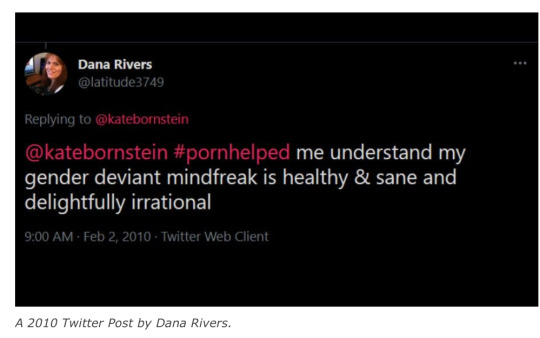
Members of the Center Unified School Board who voted for Rivers’ dismissal argued that the decision had nothing to do with his gender identity, but rather due to concern for the rights of parents, some of whom had complained to the school administrators that Rivers had been discussing inappropriate and sexual aspects of his ‘transition’ with students.
According to a 1999 article in The New York Times, one parent stated that “[Rivers] said he had been sodomized as a youth and that he always felt he was a woman trapped in a man’s body and that he was going to be changing into a woman in the fall. He should have gotten permission from the parents to say this.”
Following the administration’s decision not to renew his employment, Rivers subsequently initiated a widely-publicized discrimination lawsuit that launched his career as a trans activist and resulted in a compensatory award of $150,000. He appeared on the Today Show and Good Morning America, and had even been profiled in the New York Times, quickly elevating his profile as a respected LGBT advocate.
Rivers was a keynote speaker for the National Center for Lesbian Rights as well as for The Tiffany Club, an organization founded to promote the political interests of those with “gender confusion.”
Prior to the murders, Rivers also spoke as a guest lecturer at several universities, including Stanford and UC Davis, and served as a Board Member for the International Foundation for Gender Education (IFGE).
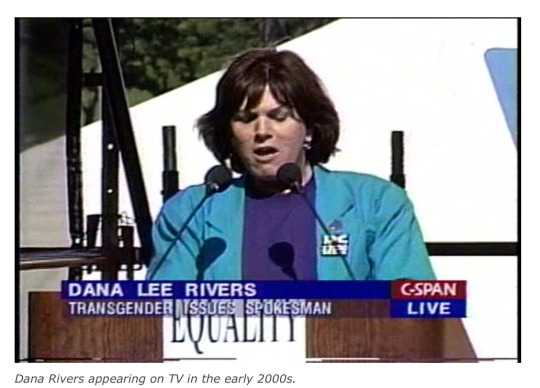
Feminist activist Kara Dansky was present as Rivers’ verdict was read, and expressed a cautious skepticism for what is coming next.
“The case is not ready to proceed to sentencing. Rivers has been found guilty, and, to the best of my understanding, the jury will be reconvened on December 5 to consider his insanity claim,” Dansky told Reduxx. She explained that Rivers’ sentencing is largely contingent on the consideration of his claim.
“If he prevails on the insanity claim, he won’t go to prison at all. Instead, he will go to a mental facility,” she said, continuing that if Rivers is sent to prison it is unclear “whether he will be placed in a women’s prison. We know that he has the right to make that application under state law.”
Under current California law, Rivers, if sent to a prison, would likely find his way into a women’s correctional institution, if not accommodated immediately due to his legal sex being “female.” California has one of the most liberal prisons self-identification policies in the country, something that has become a point of contention for women’s rights advocates.
S.B-132, also known as the Transgender Respect, Agency, and Dignity Act, was signed into effect in January of 2021 by California Governor Gavin Newsom. The law provides inmates housing based on their self-declared gender identity status.
Almost immediately after the legal guideline went into effect, California correctional centers were hit with hundreds of transfer requests from male inmates seeking movement into women’s facilities.
The California Department of Corrections and Rehabilitation has previously confirmed to Reduxx that prison transfer requests are based entirely off of a Gender Identity Questionnaire that could be issued during reception or requested by the inmate at any time during their incarceration.
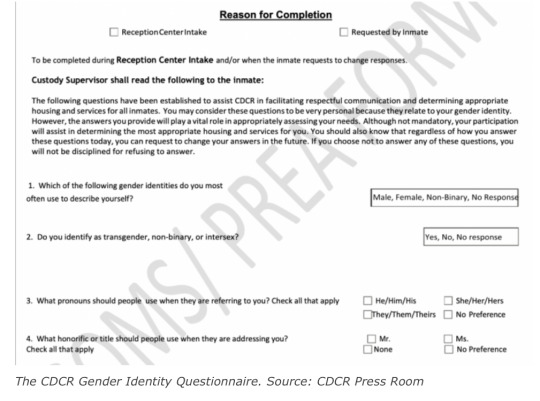
The Questionnaire is form with a short series of questions in which inmates can declare their pronouns, honorifics, and gender identity.
Male inmates do not need to identify as transgender to request transfer, and can simply identify gender non-conforming, or non-binary.
Earlier this year, Reduxx reported that a pedophile who had molested a 4-year-old girl had been moved to the California Institution for Women despite having been denied a gender and name change, and still legally being a male.
By Genevieve Gluck Genevieve is the Co-Founder of Reduxx, and the outlet's Chief Investigative Journalist with a focused interest in pornography, sexual predators, and fetish subcultures. She is the creator of the podcast Women's Voices, which features news commentary and interviews regarding women's rights.
#Dana Rivers is David Chester Warfield#Rest In Peace Charlotte Reed#Rest In Peace Patricia Wright#Rest In Peace Benny Diambu-Wright#Oakland#california#The Deviants#Another trans identified male convicted of violent crimes#The Tiffany Club#Transgender Respect#Agency#and Dignity Act#Keep Prisons Single Sex
9 notes
·
View notes
Text
Young Black Voters Motivated By Issues, Not Candidates - Capital B Atlanta
It’s a late Saturday morning at Fort Valley State University, and Jayden Williams is sounding the alarm like Dap Dunlap in “School Daze.”
“Knock knock! It’s time to vote!” the 19-year-old shouted inside a residence hall just before noon in mid-September. Williams serves as the youth and college division president for the Georgia NAACP. He and his team members spent about 20 minutes venturing through the building’s third-floor corridor, knocking on every door.
Several drowsy students wearing scarfs, bonnets, and du rags cracked open their doors and poked their heads out. FVSU freshman class president Kennedy McIntyre was there to greet some of them. Moments later, dozens of students flooded a first-floor common area before making their way outside and across the lush, freshly landscaped campus during the hot and sunny day. Williams, McIntyre, and campus NAACP president Aniya Warfield led the way.
Their destination was a grassy field across the street from Wildcat Stadium where voter engagement activists from the Black Voters Matter Fund, the NAACP, the ACLU, Represent Georgia and Georgia Stand-Up, among other groups, had set up tents and tables to catch the attention of people who came to watch the school’s undefeated football team take on the Allen University Yellow Jackets.
A DJ blasted southern rap music while some students stood in line for Ben & Jerry’s ice cream. Others couldn’t resist snapping selfies in front of the eye-catching Black Voters Matter charter bus parked nearby. FVSU’s Blue Machine Marching Band and drill team members strolled down a nearby street as volunteers passed out Black Voters Matter T-shirts, drawstring backpacks, bracelets, and other swag to students and alumni.
This was day two of the Black Youth Renaissance Tour, a collaborative, nonpartisan, get-out-the-vote effort organized by Black Voters Matter and several of its local grassroots partners.
The goal of the five-day caravan and charter bus trek to six HBCU campuses across the state — beginning a day prior at Albany State University on Sept. 16 and ending at the Atlanta University Center on Sept. 20 — was to register and energize as many Black students as possible before Nov. 8.
All of the fanfare — the fancy bus, the music, the ice cream, and the free apparel — is designed to attract crowds, particularly young, Black potential voters.

Georgia’s last gubernatorial matchup in 2018 was decided by fewer than 55,000 votes. Since then, at least 1.6 million more people have registered to vote across the state. An additional crop of potential new voters resides at the state’s HBCU campuses. FVSU alone has a population of more than 3,000 students, most of whom are adults between the ages of 18 and 34.
That demographic group of young voters cast ballots in record numbers in 2020 and last year, helping Democrats in Georgia secure landmark victories in the process. Young and rural Black voters are expected to play pivotal roles in the outcome of this year’s midterm contests as well, despite being among the least motivated groups.
Violent crime, COVID, monkeypox, lack of affordable housing, low-wage employment, hospital closures, student loans, higher utility bills, and overall inflation are some of the major issues disproportionately impacting Black Georgians this midterm election season.
BVM’s Georgia state organizing manager Melinee Calhoun is one of the activists who’ve worked tirelessly in recent years to mobilize the state’s rural Black population. She acknowledged that Black voters she’s encountered this year aren’t as energized as they were during the past two election cycles.
“People aren’t as motivated right now, but that’s why we’re pushing hard,” Calhoun said.
Represent Georgia Executive Director Kimberlyn Carter also recognized the frustrations that Black voters she’s encountered this year have expressed. Many voters in rural parts of the state voted for the first time ever during previous election cycles, only to have problems plaguing their communities get worse during the pandemic economy.
“Every presidential year, we go, ‘This is the election of the lifetime,’” Carter said. “We have gotten voters to the point where, ‘OK, we’re tired of hearing that.’”
Focused on issues, not candidates
Many students who participated in the voter engagement festivities said they don’t usually follow politics closely. Some were only vaguely familiar with household names like Gov. Brian Kemp, Stacey Abrams, Raphael Warnock, and Herschel Walker.
But most were aware of and concerned about the issues affecting their state and local communities. One major issue was the recent reinstatement of Georgia’s 2019 abortion restriction law following the U.S. Supreme Court’s overturn of Roe v. Wade, which had a galvanizing effect on young voters this summer.
“Once those rights have been taken away from you, it kind of makes it harder on you,” said Albany State University sophomore Chasely Sellers.

Some time before Election Day, BVM will mail those pledge forms back to those who signed them to remind them of their promise and the campaign issues they said they care about the most.
BVM also works with volunteer residence hall captains on campus to ensure students have what they need to vote on or before Election Day.
“If they need a ride to the polls, their hall captain is going to ensure that,” Miller said. “If they need to vote by mail, their hall captain ensures that they get that vote by mail application.”
Freshman BreAnna Mitchell, 18, was one of the FVSU students who registered to vote for the first time. The nursing major said addressing gun violence is her top issue this year following the fatal shooting of her cousin in Atlanta three years ago.
Mitchell recalled Kemp enacting a law earlier this year that made it legal for “lawful weapons carriers” to carry concealed handguns without a permit.
“It should be illegal to carry a gun,” she said. “Even if you have a license, you just shouldn’t have it.”
Addressing gun violence was a recurring desire for students and activists throughout the five-day tour. One of those people was FVSU freshman Tynika Howell, 18, whose family moved from Buffalo, New York, to nearby Warner Robins, Georgia, about five years ago.
Howell recalled a 13-year-old boy being arrested and charged in Warner Robins last year in the fatal shooting of his own mother.
“When I was in high school, there were 15-year-olds with guns,” she said. “There is no reason anybody 13, 14, 15 should have a gun in my opinion.”
‘We have no jobs’
Catholine Walton, 31, was more focused on getting her new podcast idea up and running than who’s running for office when BVM activists did some door-to-door canvassing in her Buena Vista neighborhood on Sept. 18.
The Blessed Crown Beauty Supply store she opened in March 2020 recently closed due to slow business caused by the pandemic, she said. Walton suggested financial literacy and entrepreneurship are better paths to empowering Black folks than politics.
“If we are not out here being a part of the system making money, putting jobs into the community, I mean, what do we really benefit from whoever is in [office]?” she said.
Like many Black residents in Buena Vista, Jade Kendrick sees the poor local job market as a major concern. The 26-year-old is a stay-at-home mother of two who said she’s been unemployed for about a year after dropping out of nursing school at Valdosta Tech to take care of her children amid the pandemic.
“We have no jobs for moms down here who don’t have help,” she said. “We need more babysitting. We need more income, period, for moms who don’t get it.”
An Atlanta Journal-Constitution poll from September showed Abrams receiving about 80% support from Black voters who were surveyed. Black voters tend to favor Democrats by an overwhelming margin in most elections. Abrams received 93% of the Black vote during her first matchup against Kemp in 2018.
Georgia and beyond
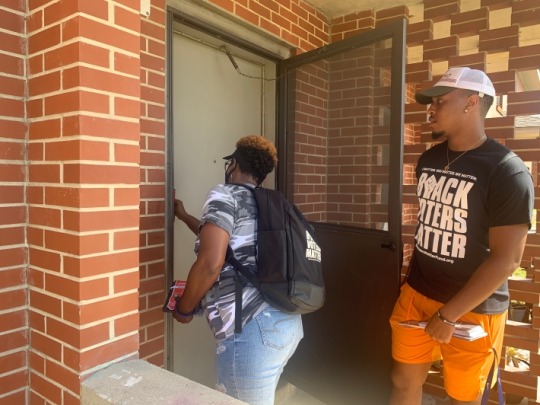
The largest crowds on the bus tour occurred at the AUC in Atlanta on Sept. 20, where hundreds of students from Clark Atlanta University, Morehouse College, and Spelman College participated in National Voter Registration Day festivities.
Members of a local Delta Sigma Theta Sorority Inc. chapter led a step show in front of CAU’s student center during the early afternoon.
Louisiana native Rayven Bryant, 19, is a sophomore at Spelman who said she plans to vote absentee in her home state’s midterm elections this year. She’s most concerned about abortion rights after a Louisiana judge blocked a trigger law from taking effect in July following the Supreme Court’s overturn of Roe v. Wade.
“Just being on campus with women, it’s always very hard to continuously see us be oppressed,” Bryant said. “My heart is still in Louisiana. … I want to be an active part of those politics and changing those issues as well.”
Several of the students who showed up for the fun were already registered to vote in other states, which Miller said is common at HBCU campuses.
“They don’t have to change their voter registration because they still are impacted by issues in their home state, but what we do is we give them a plan and a pledge to vote wherever they are,” she said. “Hopefully, a majority will choose to register here. Most college students stay in the state where they went to school or graduated from college.”
Morehouse senior Jalen Curry is a Rock Hill, South Carolina, native who plans to vote absentee in his home state.
“I think right now it’s very hard just to live,” he said. “It’s hard to go to school. It’s hard to get a job. It’s hard to find somewhere to stay. It’s just hard to exist.”
2 notes
·
View notes
Text
You Are Here: Maps, Neighbors, and Ice Cream
By: Lisa Timmerman, Executive Director
On 08/21/1986, Cecil Garrison drew a map of Dumfries as he remembered it from the 1910s-1920s. Noting everything from cornfields to families such as the Waters and Keys, he recalled a tight knit social community based on his recollections and memories of his former neighbors. Based on recollections, censuses, and social notes in newspapers we can help construct some of the social atmosphere in Dumfries around that time.
One event not to miss occurred on 11/25/1921 when Mr. and Mrs. Robert A. Waters celebrated their “silver” 25th wedding anniversary. Dazzling in a black satin gown with jet ornaments and flowers, Mrs. Waters opened her home to celebrations along with her husband, who incidentally, was still able to sport his wedding suit. The guest list tagged many of the notable Dumfries families including, but not limited to, “Mr. and Mrs. George M. Ratcliffe, Mr. and Mrs. H. Clay Speake, Messrs. Ruel and George Waters, Mr. and Mrs. Willis W. Sisson, Mr. and Mrs. Claud Brawner, Mr. and Mrs. Eastman Keys, Mr. and Mrs. James Garrison, Mr. and Mrs. Randolph Brawner, Mr. and Mrs. Elvan Keys, Mrs. Warfield Brawner, Mrs. Jack Keys, Mrs. Clay Brawner, Mrs. William Speake, Mrs. Ethel King, Mr. and Mrs. Cecil Garrison.” The Manassas Journal, featuring this event on the front page of their newspaper, reported delightful details such as how Mrs. Claud Brawner played the piano and sang for entertainment while Mrs. Willis W. Sisson and Miss Constance Waters “presided” over the punchbowl. Hungry? Try a slice of cake and ice cream and cheer to the happy couple as they received “beautiful and useful gifts of silver” along with well wishes and “many happy returns of the day”.

Early 20th century newspapers, like The Manassas Journal, reported on the comings & goings of people the editors deemed worthy of social gossip. Besides for feature articles on certain events, “Brief Local News” and “Little Journeys” informed readers of a variety of useful and useless knowledge. “Brief Local News” offered a bevy of interesting information, from an individual’s propriety (illness, accident) to an organization’s travel for competition. “Little Journeys” notified the community of people traveling to and from the area and who they stayed with – perhaps even mentioning well-known family and friend connections. The editors found the Ratcliffe’s of Manassas particularly intriguing as they later mentioned in the same 12/02/1921 paper that reported the silver anniversary, “Mr. and Mrs. G. Raymond Ratcliffe and their two children, Jack and Rose, Mrs. R.J. Adamson and Miss Constance Waters spent the Thanksgiving holiday in Dumfries and attended the silver anniversary of Mr. and Mrs. Robert A. Waters.”
Adults were not the only ones throwing parties in Dumfries in the early 1920s. On 02/03/1922, Mrs. D.C. Cline invited the “young folks” of Dumfries to her home “…in honor of her friend, Madame Seemoure, of Richmond, who entertained them until a late hour with her wonderful magic in making a table walk and talk. Also a masterhand with the Ouija board. After the fun, ice cream was served.” The Ouija board experienced a surge of popularity in the 1920s as Americans embraced spiritualism and struggled to grasp with the devastation caused by The Great War.
Not only did Garrison’s recollections provide a visual of some of the streets of Dumfries, it also serves as a jumping off board to study the different social connections. Combined with census data and newspaper’s social notices, we can confirm locations, events, and Dumfries apparent love of ice cream at parties.
Note: Need an ice pop? We do! Join us next Saturday, 08/21, in Merchant Park as we provide scavenger hunt clues, sachet craft materials, and an ice pop all celebrating the wonderful flowers and herbs found on our property! Join the waitlist here!
(Sources: Maps: Dumfries – Pre 1961; The Manassas Journal, Vol. XXVII, No. 29, 12/02/1921 & Vol. XXVII, No. 39, 02/10/1922; McRobbie, Linda Rodriguez. The Strange and Mysterious History of the Ouija Board. Smithsonian Magazine Online, accessed 08/12/2021).
#localhistory#community#socialevent#maps#archives#museumfromhome#hello neighbor#parties#genealogy#familyhistory#familymemories#folklore#weloveicecream
2 notes
·
View notes
Photo

On July 11, 1947, the Exodus (formerly the packet steamer SS President Warfield) was intercepted by the British Navy off the coast of Haifa. The ship was carrying 4,500 Jewish men, women and children, virtually all of them Holocaust survivors. The ship was escorted into port, where the bedraggled passengers were
transferred to three other ships, Ocean Vigour, Empire Rival and Runnymede Park and, quite incredibly,returned to Germany (after first docking in France, where, on the advice of the Haganah, the passengers refused to disembark). They were then placed in DP (displaced persons) camps. Try to imagine the sheer horror of being returned to Germany after surviving the Holocaust. By the time Israel declared independence, most (by various means) were able to complete the journey they had begun in hope the previous year.
The second vessel is the first of four new state-of-the-art Sa’ar 6 warships, which docked in Haifa on December 2, 2020
and will protect Israel’s coastline (and its people) for many years to come.
#exodus #AmYisraelChai #neveragain
Likud UK
28 notes
·
View notes
Photo

#OnThisDay in 1947, the SS Exodus carrying approximately 4,500 Jewish refugees from France to British Mandate Palestine were turned away for lack of immigration paperwork. Of the 64 vessels that took part in Aliya Bet, or an immigration scheme to move Jewish people to British Mandate Palestine after WWII, the Exodus held the largest-ever number of illegal immigrants to Palestine. The British intercepted the ship, and passengers challenged them. Two passengers died from gunshot wounds, 10 passengers were treated for mild injuries, and two British sailors were also treated. The British sailed the ship into the port at Haifa and transferred the passengers to deportation ships, which would take them back to Displaced Persons camps in Germany. On September 29, 1947, the militant Zionist groups Irgun and Lehi blew up Central Police HQ in Haifa in retaliation. 10 people were killed and 54 injured, of which 33 were British. Four British policemen, four Arab policemen, an Arab woman and a 16-year-old were killed. The 10-story building was so heavily damaged that it was later demolished. The ship was formerly the packet steamer SS President Warfield for the Baltimore Steam Packet Company. She launched in 1928, and until 1942, carried passengers and freight between VA and MD. During WWII, she served both the UK and US Armies. The damaged Exodus, like many other Aliyah Bet ships, was moored to a breakwater in Haifa. The creation of the State of Israel in 1948 brought massive immigration of European Jewish refugees from displaced persons camps to Israel. There was little time or money to focus on the meaning of the Exodus. Abba Khoushy, the Mayor of Haifa, proposed in 1950 that the "Ship that Launched a Nation" should be restored and converted into a floating museum of the Aliyah Bet. During the process of restoring the ship that had been left decaying in the port, an unexplained accident occurred and the Exodus burned to the waterline on August 26, 1952. https://www.instagram.com/p/CCgLU7hH9y-/?igshid=e8n2fbnv6v7q
7 notes
·
View notes
Text
Martin Lawrence
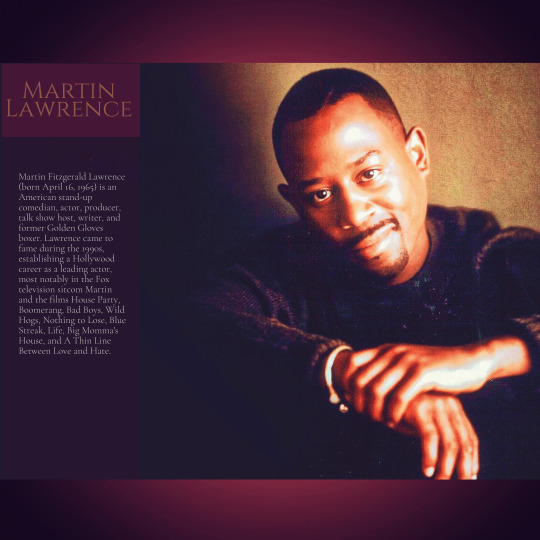
Martin Fitzgerald Lawrence (born April 16, 1965) is an American stand-up comedian, actor, producer, talk show host, writer, and former Golden Gloves boxer. Lawrence came to fame during the 1990s, establishing a Hollywood career as a leading actor, most notably in the Fox television sitcom Martin and the films House Party, Boomerang, Bad Boys, Wild Hogs, Nothing to Lose, Blue Streak, Life, Big Momma's House, and A Thin Line Between Love and Hate.
Early life
The fourth of six children, Martin Fitzgerald Lawrence was born on April 16, 1965, in Frankfurt, West Germany, to American parents. His father, John Lawrence, was serving in the U.S. military at the time. Lawrence was named after civil rights leader Martin Luther King Jr. and U.S. President John F. Kennedy. When Lawrence was seven, his father left the military, and the family moved from Germany back to the United States, settling in Landover, Maryland, in the Washington, D.C., area. After his parents divorced in 1973, Lawrence rarely saw his father, who was a police officer. His mother, Chlora (née Bailey), worked several jobs, including as a sales representative and cashier at various department stores to support her family.
During his teen years, Lawrence excelled at boxing.
While living in Maryland, Lawrence attended Eleanor Roosevelt High School and Friendly High School, and he lived in Apple Grove, becoming a Mid-Atlantic Golden Gloves boxing contender.
Career
In his early days, Lawrence did comedy shows in the Washington, D.C., area and supported himself through odd jobs. Comedian, Ritch Snyder saw his act and suggested Lawrence make connections in New York. Lawrence ended up moving to New York City and found his way to the legendary The Improv. Shortly after appearing at The Improv, Lawrence won a performance spot on Star Search. He did well on the show and made it to the final round, but did not win. However, executives at Columbia Pictures Television saw Martin's performance and offered him the role of Maurice Warfield in What's Happening Now!!; this was his first acting job. Upon cancellation of that show, Lawrence found bit parts in various films and television series. His breakthrough role was as Cee in Do the Right Thing. Other roles followed in films such as the House Party series, Talkin' Dirty After Dark, and the Eddie Murphy vehicle Boomerang. During this period, entertainment mogul Russell Simmons selected him to host the groundbreaking series Def Comedy Jam on HBO. Def Comedy Jam gave many comedians (including Chris Tucker, Dave Chappelle, Mike Epps, Bernie Mac and Cedric the Entertainer) mainstream exposure.
During his stint with Def Comedy Jam, Lawrence appeared in his own hit series, Martin, which aired on Fox. The show ran from 1992 to 1997 and was an enormous success. Martin was the flagship of Fox's Thursday-night line-up, which drew millions of viewers away from NBC's "Must See TV" line-up. He hosted Saturday Night Live on February 19, 1994, where he made crude remarks about women's genitalia and personal hygiene; the monologue was completely edited out of NBC reruns and syndicated versions, and Lawrence was banned from the show for life. Martin's ratings continued to skyrocket so much that Fox became more of a contender against NBC and came closer to being considered among the top television networks.
After Martin ended its run in 1997, Lawrence found work in comedy films. He often starred as the second lead opposite actors including Eddie Murphy, Danny DeVito, and Tim Robbins. Many of his films were blockbusters at the box office, including Nothing to Lose, Life, Blue Streak, and Big Momma's House. He also starred in critical- and box-office failures, including Black Knight and National Security. Regardless, his salary steadily increased to over $10 million per film role. He continues to work in film, with such films as Big Momma's House 2, which opened at No. 1 at North American box office and grossed almost $28 million its first weekend, and Wild Hogs (2007), in which he played a bored suburbanite seeking adventure on the open road in a biker comedy alongside John Travolta, Tim Allen and William H. Macy.
In 2006, Lawrence appeared on Inside the Actors Studio, during which Lawrence briefly brought back to life some of the characters he had portrayed on Martin. He also appeared in Open Season as Boog, one of the main characters of the film. The movie also starred Ashton Kutcher, Debra Messing, and Gary Sinise.
In 2008, Lawrence starred in Disney's College Road Trip co-starring with Raven-Symoné. It was his first G-rated film, but not his first appearance in a children's film: he supplied a voice for Open Season (2006) opposite Ashton Kutcher.
At the 2009 BET Awards he appeared in a spoof movie trailer with Jamie Foxx for a fictional movie, The Skank Robbers, that featured their respective television characters Sheneneh Jenkins and Ugly Wanda. In 2010, Fox announced that it was producing a film based on the sketch, featuring Foxx, Lawrence, and actress Halle Berry.
In 2011, Lawrence reprised his role as FBI agent Malcolm Turner in Big Mommas: Like Father, Like Son, the third film in the Big Momma series.
In January 2013, it was announced that Lawrence and Kelsey Grammer were considering pairing up to star in a comedy for Lionsgate TV. Partners, paired the two actors as Chicago lawyers from "vastly different backgrounds who unexpectedly meet in court on the worst day of their lives." The show premiered August 4, 2014, but was cancelled after one season after receiving poor reviews.
In 2020, Lawrence reprised his role as Detective Marcus Burnett in the third installment of the Bad Boys franchise, Bad Boys for Life, again alongside Will Smith. The film was considered a financial success, grossing $112 million in its first four days of release.
Personal life
Relationships and family
Lawrence was engaged to actress Lark Voorhies in 1993. He married Miss Virginia USA, Patricia Southall, in 1995. Lawrence and Southall have a daughter, Jasmine Page (born January 15, 1996). They divorced in 1997. In 1997, Lawrence began a relationship with Shamicka Gibbs. They married on July 10, 2010, at Lawrence's Beverly Hills home. Actors Eddie Murphy and Denzel Washington were among the 120 wedding guests; Lawrence and Gibbs have two daughters, Iyanna Faith (born November 9, 2000) and Amara Trinity (born August 20, 2002). Lawrence filed for divorce from Gibbs on April 25, 2012, citing irreconcilable differences and asking for joint legal and physical custody of the children.
Lawrence owns a farm near Purcellville, Virginia. For several years, he owned a large mansion in the Beverly Park community in Beverly Hills, where he wedded Gibbs. However, following their divorce, the property was available for lease at $200,000 per month in June 2012. In 2013, the property was up for sale for $26.5 million, and eventually he sold it for $17.2 million to Bruce Makowsky, buying an Encino, Los Angeles property for $6.63 million.
Arrests, lawsuits and health problems
In July 1995, while on the set filming A Thin Line Between Love and Hate, Lawrence lashed out in a violent rage and was then hospitalized at Cedars-Sinai Medical Center.
On May 8, 1996, he became increasingly erratic and was arrested after he brandished a pistol in the middle of an intersection on Ventura Boulevard in Los Angeles, screaming, "They're trying to kill me!" He was again hospitalized, with his public-relations agent citing exhaustion and dehydration as the reasons for this episode.
In January 1997, Lawrence's Martin co-star Tisha Campbell-Martin filed a lawsuit against him, alleging sexual harassment and abuse both on and off set. By April 1997, Campbell had settled the lawsuit, and returned to appear in the last two episodes of the series.
In March 1997, Lawrence was arrested after punching a man in a Hollywood nightclub.
During August 1999, Lawrence slipped into a three-day coma after collapsing from heat exhaustion while jogging in 100 °F (38 °C) heat in preparation for Big Momma's House while wearing heavy clothing and a "plastic suit." He recovered in the hospital after nearly dying due to a body temperature of 107 °F (42 °C), his breathing assisted by a ventilator.
Filmography
FilmTelevision
Discography
Awards and nominations
Blockbuster Entertainment Award
NAACP Image Award
Kids' Choice Award
MTV Movie Award
ShoWest – Male Star of Tomorrow (1995)
Teen Choice Award – nominated for Wipeout Scene of the Summer (2000) for the movie Big Momma's House
BET Comedy Award – won Icon Comedy Award (2005)
nominated with Eddie Murphy for Favorite Comedy Team (2000) for the movie Life
nominated for Favorite Actor (2001) for the movie Big Momma's House
won Outstanding Lead Actor in a Comedy Series (1995) for the series Martin
won Outstanding Lead Actor in a Comedy Series (1996) for the series Martin
nominated for Outstanding Lead Actor in a Comedy Series (1997) for the series Martin
nominated for Favorite Television Actor (1995) for the series Martin
nominated for Favorite Television Actor (1996) for the series Martin
nominated for Favorite Movie Actor (2001) for the movie Big Momma's House
nominated with Will Smith for Best On-Screen Duo (1996) for the movie Bad Boys
nominated for the movie Big Momma's House
nominated with Will Smith for Best On-Screen Team (2003) for the movie Bad Boys II
13 notes
·
View notes
Photo

A photograph of Wilson College president Ethelbert Warfield seated at his desk.
Wilson College Historic Photographs
2 notes
·
View notes
Text
History
June 3, 1937 - The Duke of Windsor married Wallis Warfield Simpson in Monts, France. As King Edward VIII, he had abdicated the British throne in December of 1936 amid tremendous controversy to marry Simpson, an American who had been divorced. Following the wedding, the couple lived in France and had minimal contact with the British Royal family. The Duke died in Paris on May 28, 1972, and was buried near Windsor Castle in England.
June 3, 1972 - Sally Jan Priesand was ordained a rabbi thus becoming the first woman rabbi in the U.S. She then became an assistant rabbi at the Stephen Wise Free Synagogue in New York City.
June 3, 1989 - Ayatollah Ruhollah Khomeini, leader of the Islamic Revolution in Iran, died. On February 1, 1979, after 15 years in exile, he had staged a triumphant return to Iran which led to the downfall of the Shah. Khomeini then reorganized the government on Islamic principles. On November 11, 1979, a group of students loyal to Khomeini seized 66 hostages in the American Embassy in Teheran after the former Shah had entered the U.S. for medical treatment. Thus began an international political crisis lasting until January 20, 1981, when they were released.
Birthday - Confederate president Jefferson Davis (1808-1889) was born at Todd County, Kentucky. After the Southern states formed the Confederacy in 1861, he hoped to be named commander of the Confederate military forces but was instead chosen to be president, serving until 1865. Following the Civil War, he was imprisoned but never brought to trial. He died at age 81 in New Orleans.
0 notes